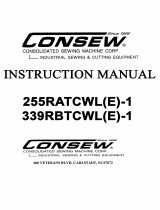
8
3.4.3 Setting the tensioning mechanisms
of the main tensioners
In the rest position of the tensioners, when pushing the plate
of the tensioners on the spot A 3.4.1, this plate must have
the socalled dead travel of about 0,5 mm. At this lifting, the
tension discs of the tensioners must not be relieved. This can
be attained by a suitable shaping of the relieving disc of the
tensioners - this has been set up in the manufacturing factory.
In the maximum opened position of the tensioners, the plate
of the tensioners, when pushing it at the spot A 3.4.1, must
still have the minimum lifting. This can be attained when axially
shifting the lever (3) with the roller (5) on the shaft (4).
The disengagement of the main tensioners must be
coordinated with the presser foot lift. To achieve this, turn the
lever (3) with the roller (5) on the shaft (4). The movement of
the roller (5) on the slanting surface (6) of the lever (7)
disengages the tensioners. In this way, also alag of the upper
thread tension disengagement after the presser foot lift can
be obtained.
Caution ! Danger of injury!
Switch off the main switch! Before starting the
setting operation, wait until the motor stops!
-
Remove the rear cover with the presser foot lift magnet.
- Loosen the screws (1) and (2) of the lever (3).
- In the rest state of the machine (with not relieved tensioner
discs) set the lever (3) in turning it slightly on theshaft (4)
to a position in which the roller (5) of the lever (3) is in
contact with theslanting surface (6) of the lever (7) and is
about 0.1 mm distant from the flat surface (8) of thelever.
- At the maximum lift of the presser foot, the roller (5) moves
on the flat surface (9) of the lever (7); in this condition,
there must be a minimal play at the tensioner plate lift (when
pushing qat the spot A (3.4.1), the plate must still have a
minimum lifting - between the roller (5) and the surface (9)
there is a minimum clearance). Retighten the screws (1) and
(2), check the play, and correct it in case of need.
3.4.4 Setting the adapting spring
The mechanism of the adapting spring is in the machine arm
set by the pin (1) and fixed by the screw (2). The axial
adjustment shall ensure that the surfaces of the parts (3) and
(4) are aligned (the threaded thread must in no place break on
edges). The initial position of the adapting spring (5) shall
ensure that B = 1 to 1.5 mm (see the Figure).
Caution! Danger of injury!
Switch off the main switch! Before starting the
setting operation, wait until the motor stops!
-
Loosen the screw (2) and take the mechanism out of the
machine arm.
- Turning the body (6) relative to the pin (1), set the required
initial position of the adapting spring /the screw (7) has
been set at the producer´s so as to permit the turning
movement of the body (6) the screw must not be fully
tightened/.
- During the installation of the mechanism into the machine
arm take care of the axial adjustment of the mechanism.
- Retighten the screw (2) and check the adjustment.
- Loosen the nut (8) of the mechanism, insert a screwdriver
into the notch of the screw (9) and set the required value of
the adapting spring. By turning the screw clockwise you
increase the spring force, and vice versa.
- Retighten the nut (8) and check the function of the adapting
spring.
4 1 7
3 2
5
8
0,1
6
9
8
3
4
5
A
9
6
7
1
2
8
9
































